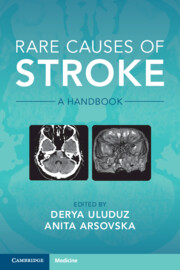Book contents
- Rare Causes of Stroke
- Rare Causes of Stroke
- Copyright page
- Contents
- Contributors
- Preface
- 1 Inflammatory Conditions
- 2 Infectious and Postinfectious Vasculitis
- 3 Hypercoagulable Causes of Stroke
- 4 Drug-Related Stroke
- 5 Hereditary and Genetic Causes of Stroke
- 6 Rare Causes of Cardioembolism
- 7 Vasospastic Conditions and Other Vasculopathies
- 8 Other Non-inflammatory Vasculopathies
- Chapter 8.1 Moyamoya Disease
- Chapter 8.2 Cerebral Amyloid Angiopathy
- Chapter 8.3 Dolichoectasia and Fusiform Aneurysms
- Chapter 8.4 Carotid Artery Dissection
- 9 Venous Occlusive Conditions
- 10 Bone Disorders and Stroke
- Index
- References
Chapter 8.1 - Moyamoya Disease
from 8 - Other Non-inflammatory Vasculopathies
Published online by Cambridge University Press: 06 October 2022
- Rare Causes of Stroke
- Rare Causes of Stroke
- Copyright page
- Contents
- Contributors
- Preface
- 1 Inflammatory Conditions
- 2 Infectious and Postinfectious Vasculitis
- 3 Hypercoagulable Causes of Stroke
- 4 Drug-Related Stroke
- 5 Hereditary and Genetic Causes of Stroke
- 6 Rare Causes of Cardioembolism
- 7 Vasospastic Conditions and Other Vasculopathies
- 8 Other Non-inflammatory Vasculopathies
- Chapter 8.1 Moyamoya Disease
- Chapter 8.2 Cerebral Amyloid Angiopathy
- Chapter 8.3 Dolichoectasia and Fusiform Aneurysms
- Chapter 8.4 Carotid Artery Dissection
- 9 Venous Occlusive Conditions
- 10 Bone Disorders and Stroke
- Index
- References
Summary
Moyamoya disease (MMD) is a cerebrovascular disorder characterised by progressive stenosis of the terminal portion of the internal carotid artery (ICA). The perforating arteries in the basal ganglia and thalamus markedly dilate and serve as an important collateral circulation, known as “Moyamoya” vessels. The clinical presentations of MMD include TIA, ischemic strokes, haemorrhagic strokes, seizures, headaches, and cognitive impairments. We present a 26-year old female patient that was examined due to headaches. For eight months, she had been admitted daily into the emergency hospital due to acute, unbearable headaches, which woke her up from her sleep. The MRI showed abnormalities suspicious for Moyamoya disease, which were confirmed with angiography
- Type
- Chapter
- Information
- Rare Causes of StrokeA Handbook, pp. 309 - 313Publisher: Cambridge University PressPrint publication year: 2022



